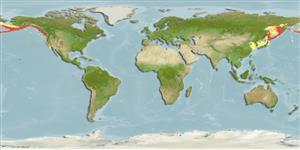分類 / Names
俗名 | 同種異名 | Catalog of Fishes(屬, 種) | ITIS | CoL | WoRMS | Cloffa
Teleostei >
Gadiformes (Cods)
鱈形目 (Cods) >
Gadidae (Cods and haddocks)
鱈科 (Cods and haddocks)
Etymology: Gadus: Latin, gadus = a fish, cod? (Ref. 45335); macrocephalus: macrocephalus meaning large head (Ref. 6885).
Environment: milieu / climate zone / depth range / distribution range
生態學
海洋; 半鹹淡水 居於水底的; 海洋洄游的 (Ref. 51243); 深度上下限 10 - 1280 m (Ref. 50550), usually 100 - 400 m (Ref. 54440). 溫帶; 6°C - 9°C (Ref. 11800); 63°N - 31°N, 119°E - 119°W (Ref. 54440)
Arctic: Chukchi and Beaufort Seas eastward across Arctic Canada to western Greenland; south in the Atlantic Ocean to Gulf of St. Lawrence. Pacific Ocean: eastern Pacific to southern California at Santa Monica, and in the western Pacific to the Yellow Sea.
北太平洋: 黃海到白令海峽, 沿著 Aleutians, 與南至大約美國洛杉磯。 稀有的在它的分佈範圍的南部中。
Length at first maturity / 大小 / 重量 / 年齡
Maturity: Lm 66.6, range 23 - 85 cm
Max length : 119 cm TL 雄魚/尚未辨別雌雄; (Ref. 40637); 最大體重: 22.7 kg (Ref. 27436); 最大年齡: 25 年 (Ref. 55701)
背棘 (總數): 0; 背的軟條 (總數): 37-57; 臀棘 0; 臀鰭軟條: 31 - 42; 脊椎骨: 49 - 55. Distinguished by the presence of 3 dorsal and 2 anal fins, a long chin barbel (about 3/4 as long as the eye diameter in young, longer than eye diameter in adults), and a space between the second and third dorsal fins that is shorter than the eye diameter (Ref. 27547). Lateral line with a prominent arch under the 1st and 2nd dorsal fins, is straight toward the tail, ending under the 3rd dorsal (Ref. 27547). Brown or gray dorsally, becoming paler ventrally; dark spots or vermiculating patterns on the sides (Ref.1371). Yellow color phases are known (Ref. 27547). Fins dusky; dorsal, anal and caudal fins with white edges that are wider on anal and caudal than on dorsal (Ref. 27547).
區別的特徵為那有 3 背部的與 2個臀鰭,一個長的下巴觸鬚 (大約 3/4 長達眼直徑當幼魚時, 長度超過眼直徑當成魚時), 與一個間隔的空間第二個與第三個背鰭,那是短於眼直徑.(參考文獻 27547) 側線有在第一與第二背鰭鰭下面的一個突出的弓,是朝向尾部的直線, 結束在那下面第三背部的.(參考文獻 27547) 褐色的或灰色背面, 腹側變成灰白; 深色斑點或以蠕蟲爬跡形為裝飾的圖案側邊上.(參考文獻 1371) 黃色的色相被知道。 (參考文獻 27547) 鰭暗色的; 背鰭、臀鰭與尾鰭有白色的邊緣那是寬的肛門而尾部的之上超過背部的之上.(參考文獻 27547)
Found mainly along the continental shelf and upper slopes (Ref. 1371). Form schools (Ref. 9988). They appear to be indiscriminate predators upon dominant food organisms present (Ref. 1371). Young probably feed on copepods and similar organisms (Ref. 27547). Adults feed on fishes, octopi, and large benthic and benthopelagic crustaceans (Ref. 1371); also worms. Parasites of the species include sealworm (Phocanema decipiens) in flesh, copepod (Lernaeocera branchialis) on gills and cestode (Pyramicocephalus phocarum) in the intestine (Ref. 5951). Marketed fresh and frozen for human consumption (Ref. 2850), and also dried or salted and smoked (Ref. 9988). Eaten steamed, fried, broiled, boiled, micro-waved and baked (Ref. 9988). Used in Chinese medicine (Ref. 12166). Minimum depth from Ref. 054440.
主要地發現沿著大陸棚與上層斜坡.(參考文獻 1371) 形成魚群。 (參考文獻 9988) 在優勢的食物生物之上的似乎不加選擇的掠食者呈現。 (參考文獻 1371) 幼魚可能吃橈腳類的動物與相似的生物。 (參考文獻 27547) 成魚吃魚,章魚與大的底棲性與大洋底棲性魚種甲殼動物;(參考文獻 1371) 也吃蠕蟲。 在市場上銷售生鮮和冷凍供人類消費 (參考文獻 2850)了, 以及乾燥或鹽醃而且煙燻.(參考文獻 9988) 清蒸,油炸,火烤, 煮沸了, 微波與燒烤的.(參考文獻 9988) 被用於中藥材了。 (參考文獻 12166)
Life cycle and mating behavior
成熟度 | 繁殖 | 產卵場 | 卵 | 孕卵數 | 仔魚
From late summer to mid-winter, fish move into the deeper water (100 to 250 m) of spawning areas; move inshore to depths of 30 to 60 m after spawning (Ref. 27547). Spawning occurs once a year (Ref. 120291).北太平洋: 黃海到白令海峽, 沿著 Aleutians, 與南至大約美國洛杉磯。 稀有的在它的分佈範圍的南部中。
Cohen, D.M., T. Inada, T. Iwamoto and N. Scialabba, 1990. FAO species catalogue. Vol. 10. Gadiform fishes of the world (Order Gadiformes). An annotated and illustrated catalogue of cods, hakes, grenadiers and other gadiform fishes known to date. FAO Fish. Synop. 125(10). Rome: FAO. 442 p. (Ref. 1371)
人類使用
漁業: 高經濟性; 游釣魚種: 是的
工具
特別的報告
下載 XML
網路資源
Estimates based on models
Preferred temperature (Ref.
123201): 0.5 - 6.4, mean 2.9 °C (based on 495 cells).
Phylogenetic diversity index (Ref.
82804): PD
50 = 0.6250 [Uniqueness, from 0.5 = low to 2.0 = high].
Bayesian length-weight: a=0.00724 (0.00627 - 0.00837), b=3.10 (3.06 - 3.14), in cm total length, based on LWR estimates for this species (Ref.
93245).
營養階層 (Ref.
69278): 4.2 ±0.1 se; based on diet studies.
回復力 (Ref.
120179): 低的, 最小族群倍增時間4.5 - 14 年 (Musick et al. 2000 (Ref.
36717); tmax=25; tm=3-8; K=0.11-0.27; Fec >1million).
Prior r = 0.34, 95% CL = 0.22 - 0.51, Based on 7 stock assessments.
Fishing Vulnerability (Ref.
59153): Moderate to high vulnerability (50 of 100).
Climate Vulnerability (Ref.
125649): Moderate to high vulnerability (45 of 100).
Nutrients (Ref.
124155): Calcium = 13.9 [9.0, 26.2] mg/100g; Iron = 0.194 [0.130, 0.305] mg/100g; Protein = 17.6 [16.1, 19.0] %; Omega3 = 0.377 [0.161, 0.932] g/100g; Selenium = 14.1 [4.9, 39.4] μg/100g; VitaminA = 4.51 [0.66, 26.54] μg/100g; Zinc = 0.353 [0.271, 0.433] mg/100g (wet weight); based on
nutrient studies.
